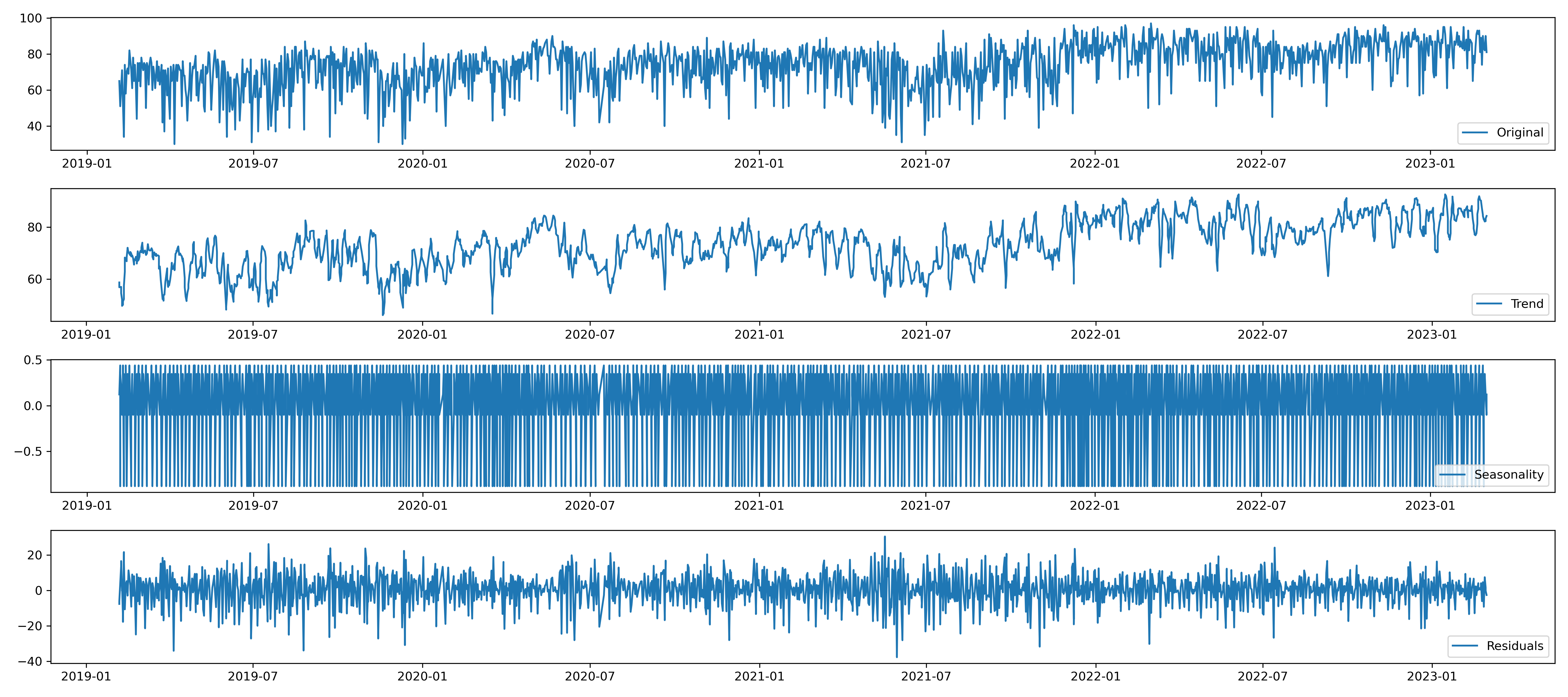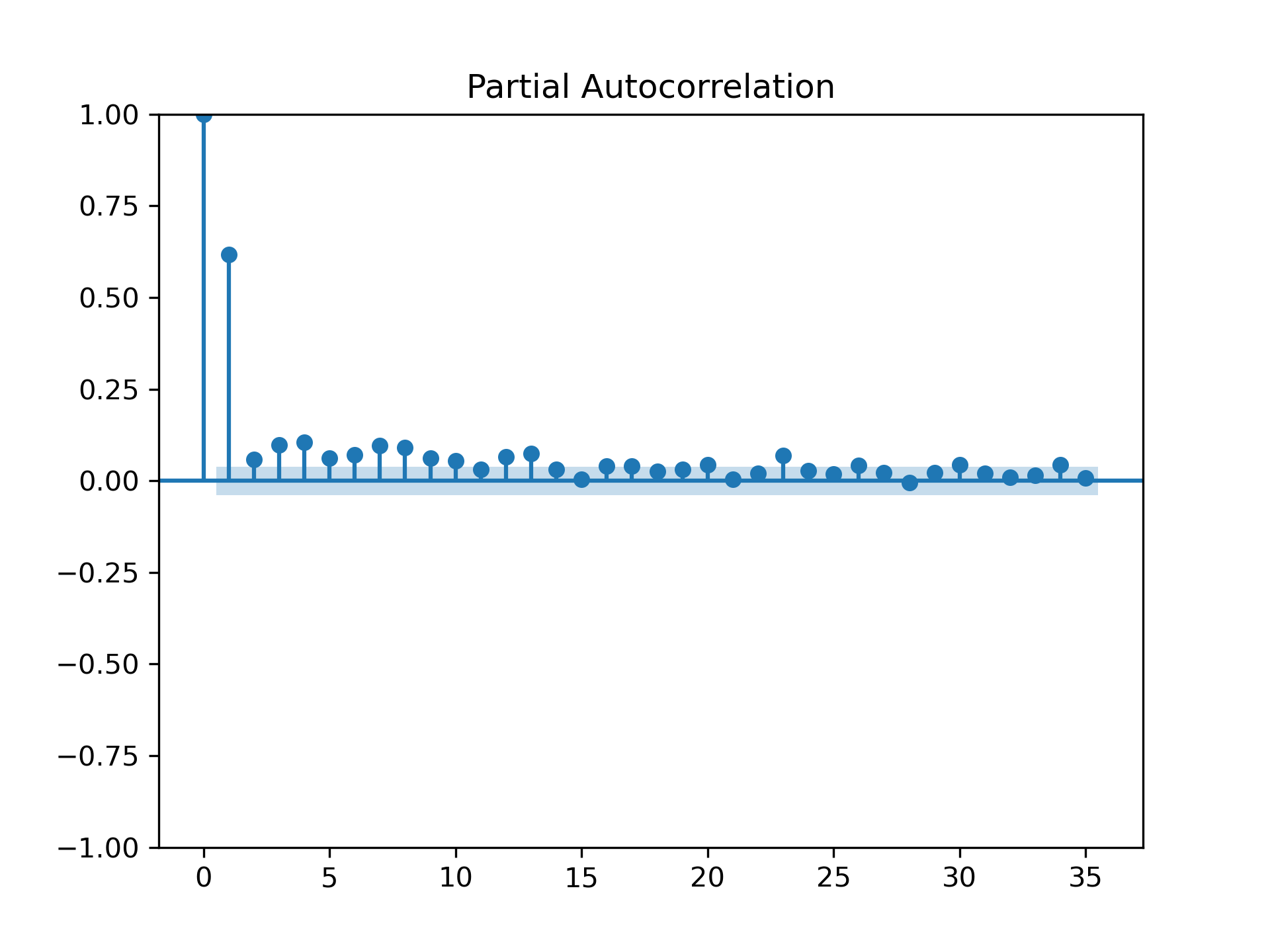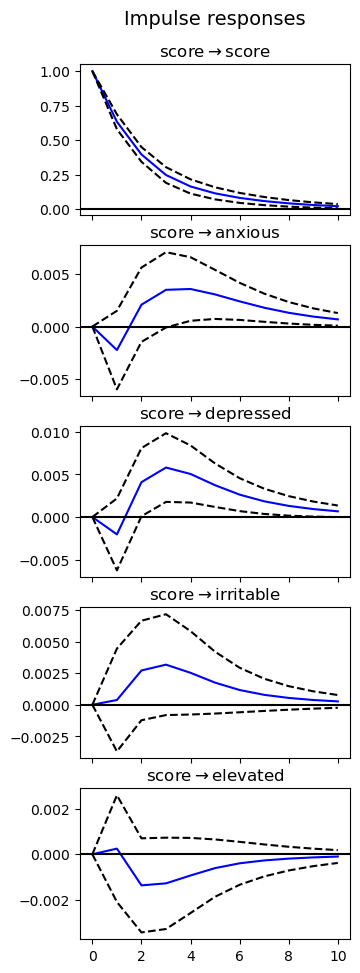Vector Autoregression (VAR) of Longitudinal Sleep and Self-report Mood Data
This is an exploratory N-of-1 analysis involving four years of my own sleep data captured via the Oura Ring, a consumer-grade sleep tracking device, and my self-reported mood data logged via eMood Tracker for iOS. After assessing the data for stationarity and computing the appropriate lag-length selection, I fit a vector autoregressive (VAR) model and performed Granger causality tests to assess causal mechanisms within this multivariate time series. Oura’s nightly sleep quality score was shown to Granger-cause presence of depressed and anxious moods using a VAR(2) model.
Introduction
Long-term self-management of chronic illnesses such as bipolar disorder require persistent awareness of illness state over long periods of time and at varying time scales
In the context of this specific illness, a volume of prior work has demonstrated the vital role of sleep in order to promote mood stability and prevent symptomatic episodes
Given the importance of sleep in the ongoing management of this illness, accurate consumer-grade alternatives to polysomnography (considered the gold standard of sleep tracking) have emerged over the last few years. Comparatively inexpensive sleep tracking technologies like the Oura Ring have dramatically improved the quality of information that can inform these self-monitoring activities. Objective sensor-based tracking technology can be complemented with subjective self-report measures in order to form a more complete picture of physical and mental health across time. Given the aforementioned interplay of sleep and mood, this combination of subjective and objective tracking creates the possibility of longitudinal analysis — and potentially deepens one’s capacity for self-awareness.
Following four years of consistent sleep and mood tracking, I wanted to interpret the data I had collected to quantify what I had intuited: that certain mood states could be understood (and potentially even predicted) by recent sleep trends. This intuition has been demonstrated quantitatively in existing literature
I describe the methods used to achieve these goals, providing an overview of vector autoregression, Granger causality, and impulse response functions. I will detail the findings of these methods on the dataset, then conclude with a discussion of the methods and their potential applications in future work.
Methods
Problem setup
A multivariate time series analysis was performed using a vector autoregressive (VAR) model fit using ordinary least squares. An optimal lag order was first obtained using a combination of Akaike Information Criterion (AIC), Bayesian Information Criterion (BIC), Hannan-Quinn Information Criterion (HQIC), and final prediction error (FPE). After fitting a VAR(2) model on the multiple time series data (described below), a Granger causality test was performed in order to assess the predictive relationships between variables. Finally, an impulse response analysis was plotted to further explore the temporal relationships between variables, specifically between sleep and self-reported mood. I outline these analysis steps in greater detail in the sections that follow.
Vector Autoregression
A VAR($p$) model for a multivariate time series is a regression model for outcomes at time $t$ and time lagged predictors, with $p$ indicating the lag. Given $p$ = 1, the model would be concerned with one observation prior to $t$. A $T \times K$ multivariate time series (where $T$ is the number of observations and $K$ is the number of variables) can be modeled using a $p$-lag VAR model
where $A_i$ is a $K \times K$ coefficient matrix.
Intercept terms are included in $\nu$ and regression coefficients are included as the subscripted $A$ values. This equation is solved using ordinary least squares (OLS) estimation. The vector autoregressive (VAR) model is a flexible method for the analysis of causality in this setting.
Granger Causality Testing
I incorporated Granger causality tests to better assess the predictive capacity of the Oura sleep score on self-reported mood states. Granger causality defines one type of relationship between time series
Two autoregressive models are fit to the first time series, once with and once without the inclusion of the second time series. The improvement of the prediction is measured as the ratio of variance of the error terms. The null hypothesis states that the first variable does not Granger cause the second variable and is rejected if the coefficients for the lagged values of the first variable are significant.
In this study, Granger causation tests were applied using sleep scores as a single predictor and each mood state as outcome variables.
Impulse Response Function Visualization
An impulse response function (IRF) is the “reaction of a dynamic system in response to an external change”
Results
Dataset Description
The sleep score dataset was created using the second- and third-generation Oura Ring. The proprietary Oura sleep score is on a scale of 1 to 100 and incorporates a variety of sensor-based measures (i.e., heart rate variability, resting heart rate, body temperature) across time. Although the specifics of this algorithm are not public, the Oura Ring has been found to produce accurate measures of sleep timing and heart rate variability when compared against polysomnography
| Value | |
|---|---|
| Total nights | 1455 |
| Missing nights | 1 |
| Mean | 73.82 |
| SD | 12.36 |
| Max | 97.00 |
| Min | 30.00 |
Each day at 4:30pm I received a notification prompting me to log my subjective state in eMood Tracker, a mobile application for iOS. eMood Tracker is “recommended by psychologists, therapists, and social workers” and is intended to “track symptom data relating to Bipolar I and II disorders”
| EMA Categories | Count |
|---|---|
| irritable | 100 |
| anxious | 88 |
| depressed | 103 |
| elevated | 48 |
Data Analysis
All analysis were performed in Python version 3.11.0 using pandas 1.5.3 for data preprocessing and statsmodels 0.13.5 for modeling. Dickey-Fuller tests of stationarity were performed using statsmodels and the pymdarima library, a clone of R’s auto.arima.
Stationarity, Decomposition, and Autocorrelation
A stationary time series contains no periodic fluctuation (“trend”). Without stationarity, the means and correlations given by a model will not accurately describe a time series’ true signal
Two Dickey-Fuller tests were performed on each time series, first via statsmodels and then, additionally, using pymdarima’s should_diff() function to assess the need for differencing. The statsmodels approach, an Augmented Dickey-Fuller test (ADF), yielded a significant $p$-value of .001 indicating support for the null hypothesis that the time series is not stationary. However, the ADF performed via the pymdarima approach using an alpha value of 0.05 yielded a non-significant $p$-value of 0.01 indicating that no differencing was required in order to produce a stationary time series. For the purposes of this study, I followed the results of the pymdarima library and assumed stationarity.
I visualized a time series decomposition to better understand the presence of trend in the sleep score dataset.

Additionally, I plotted a partial autocorrelation function using statsmodels. Notably, partial autocorrelation appears to drop to zero for lag values greater than 2.

Lag Order Selection
The number of lags amount to the number of preceding days included as predictor values in the model. The statsmodels function select_order() was used to assess an optimal lag value with possibilities between 0 and 15. The optimal lag value was determined using four information criteria — Akaike Information Criteria (AIC), Bayes Information Criterion (BIC), Final Prediction Error (FPE), and Hannan-Quinn (HQ) criterion. This selection process yielded a tie with lag-1 and lag-2 each labeled as the minimum on these criteria. In this case, I selected lag-2 based on prior knowledge of sleep quality and the onset of mood states.
| AIC | BIC | FPE | HQIC | |
|---|---|---|---|---|
| 0 | 1.688 | 1.708 | 5.408 | 1.695 |
| 1 | -0.02482 | 0.09412* | 0.9755 | 0.01979* |
| 2 | -0.03545* | 0.1826 | 0.9652* | 0.04635 |
| 3 | -0.03417 | 0.2830 | 0.9664 | 0.08481 |
| 4 | -0.02907 | 0.3872 | 0.9714 | 0.1271 |
| 5 | -0.02537 | 0.4900 | 0.9750 | 0.1680 |
| 6 | -0.01701 | 0.5975 | 0.9832 | 0.2135 |
| 7 | -0.01940 | 0.6943 | 0.9809 | 0.2483 |
| 8 | -0.01014 | 0.8026 | 0.9900 | 0.2948 |
| 9 | -0.0008049 | 0.9111 | 0.9993 | 0.3413 |
| 10 | 0.01201 | 1.023 | 1.012 | 0.3913 |
| 11 | 0.02510 | 1.135 | 1.026 | 0.4415 |
| 12 | 0.03723 | 1.246 | 1.038 | 0.4909 |
| 13 | 0.04867 | 1.357 | 1.050 | 0.5395 |
| 14 | 0.06022 | 1.468 | 1.063 | 0.5882 |
| 15 | 0.07076 | 1.577 | 1.074 | 0.6359 |
Vector Autoregression Model
All time series under analysis were found to be stationary (ADF test $p$ < .05). The results of the VAR(2) model predicting mood states using sleep score are shown below. Sleep score was found to be a significant positive predictor of depression, also confirmed via Granger causation tests. Sleep score did not positively or negatively predict other mood states in this model.
| Coefficient | Std. error | Test statistic | p-value | |
|---|---|---|---|---|
| L1.score | 0.633262 | 0.027574 | 22.966 | 0.000 |
| L1.anxious | 0.153275 | 0.446110 | 0.344 | 0.731 |
| L1.depressed | 0.477164 | 0.409130 | 1.166 | 0.243 |
| L1.irritable | -0.282988 | 0.412509 | -0.686 | 0.493 |
| L1.elevated | -0.220198 | 0.655784 | -0.336 | 0.737 |
| L2.score | -0.003080 | 0.027452 | -0.112 | 0.911 |
| L2.anxious | 0.353528 | 0.445359 | 0.794 | 0.427 |
| L2.depressed | 1.241873 | 0.409667 | 3.031 | 0.002 |
| L2.irritable | -0.080069 | 0.412341 | -0.194 | 0.846 |
| L2.elevated | -0.499540 | 0.657230 | -0.760 | 0.447 |
Granger Causality
The results of the Granger causation tests are shown below. Sleep score was shown to Granger-cause both depressed and anxious mood.
| Causal Variable | Variable | Test statistic | Critical value | p-value | df |
|---|---|---|---|---|---|
| sleepscore | depressed | 5.384 | 2.997 | 0.005 | (2, 6535) |
| sleepscore | anxious | 3.294 | 2.997 | 0.037 | (2, 6535) |
| sleepscore | irritable | 1.347 | 2.997 | 0.260 | (2, 6535) |
| sleepscore | elevated | 1.203 | 2.997 | 0.500 | (2, 6535) |
Impulse Response Analysis
As shown in the figure below, the impact of sleep score on the four self-reported mood states varies over a 10-day period. Standard errors are plotted at the 95% significance level. The effect of an impact on sleep score on depressed and anxious moods appear to be most felt only after several days of its impact, peaking at roughly 3 days and then gradually decaying.

Discussion
This exploratory study affirms the role that self-tracking technologies can play in the ongoing management of affective disorders. This type of N-of-1 analysis would be impossible without inexpensive wearable sensors, and the quality of this dataset is directly related to how non-invasive this particular wearable is.
This work is limited in several ways. My reliance on an algorithmic ADF test to assess stationarity (rather than directly assessing the data myself) could leave room for error. Additionally, this work only assesses the influence of the Oura sleep score on mood. In reality, this is likely closer to a bidirectional influence and this should be reflected properly in the analysis.
